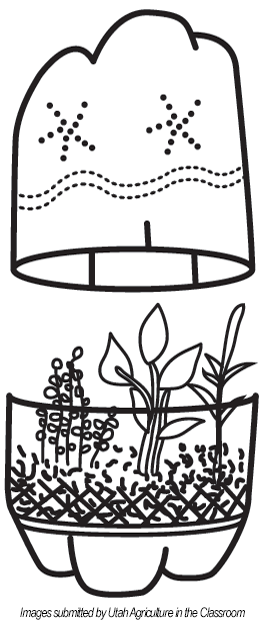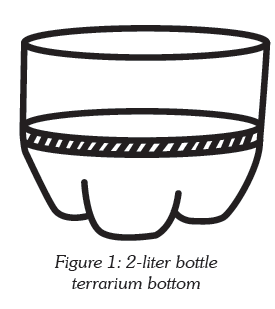Terrariums: A Look at the Living and Nonliving World
Students observe the interactions between living plants and other living and nonliving things in a small terrarium environment and discuss similarities between the terrarium environment and the farm environment.
Background
Lesson Activities
Recommended Companion Resources
Credits
Author
Debra Spielmaker | Utah Agriculture in the Classroom
Standards
Texas Content Area Standards
-
ELA: 4.110.6.b.1
Developing and sustaining foundational language skills: listening, speaking, discussion, and thinking- oral language. The students develops oral language through listening, speaking, and discussion.
- ELA: 4.110.6.b.1.D: work collaboratively with others to develop a plan of shared responsibilities
-
Social Studies: 3.113.14.c.15
Social studies skills. The student communicates in written, oral, and visual forms. The student is expected to:
- Social Studies: 3.113.14.c.15.D: express ideas orally based on knowledge and experiences
-
Social Studies: 4.113.15.c.21
Social studies skills. The student communicates in written, oral, and visual forms. The student is expected to:
- Social Studies: 4.113.15.c.21.C: express ideas orally based on research and experiences
-
Social Studies: 5.113.16.c.25
Social studies skills. The student communicates in written, oral, and visual forms. The student is expected to:
- Social Studies: 5.113.16.c.25.C: express ideas orally based on research and experiences
-
Science: 3.112.5.b.1
Scientific and engineering practices. The student asks questions, identifies problems, and plans and safely conducts classroom, laboratory, and field investigations to answer questions, explain phenomena, or design solutions using appropriate tools and models. The student is expected to:
- Science: 3.112.5.b.1.D: use tools, including hand lenses; metric rulers; Celsius thermometers; wind vanes; rain gauges; graduated cylinders; beakers; digital scales; hot plates; meter sticks; magnets; notebooks; Sun, Earth, Moon system models; timing devices; materials to support observation of habitats of organisms such as terrariums, aquariums, and collecting nets; and materials to support digital data collection such as computers, tablets, and cameras, to observe, measure, test, and analyze information
- Science: 3.112.5.b.1.E: collect observations and measurements as evidence
- Science: 3.112.5.b.1.F: construct appropriate graphic organizers to collect data, including tables, bar graphs, line graphs, tree maps, concept maps, Venn diagrams, flow charts or sequence maps, and input-output tables that show cause and effect
-
Science: 3.112.5.b.2
Scientific and engineering practices. The student analyzes and interprets data to derive meaning, identify features and patterns, and discover relationships or correlations to develop evidence-based arguments or evaluate designs. The student is expected to:
- Science: 3.112.5.b.2.C: use mathematical calculations to compare patterns and relationships
-
Science: 3.112.5.b.3
Scientific and engineering practices. The student develops evidence-based explanations and communicates findings, conclusions, and proposed solutions. The student is expected to:
- Science: 3.112.5.b.3.A: develop explanations and propose solutions supported by data and models
-
Science: 3.112.5.b.5
Recurring themes and concepts. The student understands that recurring themes and concepts provide a framework for making connections across disciplines. The student is expected to:
- Science: 3.112.5.b.5.A: identify and use patterns to explain scientific phenomena or to design solutions
- Science: 3.112.5.b.5.B: identify and investigate cause-and-effect relationships to explain scientific phenomena or analyze problems
- Science: 3.112.5.b.5.C: use scale, proportion, and quantity to describe, compare, or model different systems
- Science: 3.112.5.b.5.D: examine and model the parts of a system and their interdependence in the function of the system
-
Science: 3.112.5.b.12
Organisms and environments. The student describes patterns, cycles, systems, and relationships within environments. The student is expected to:
- Science: 3.112.5.b.12.A: explain how temperature and precipitation affect animal growth and behavior through migration and hibernation and plant responses through dormancy
- Science: 3.112.5.b.12.B: identify and describe the flow of energy in a food chain and predict how changes in a food chain such as removal of frogs from a pond or bees from a field affect the ecosystem
-
Science: 3.112.5.b.13
Organisms and environments. The student knows that organisms undergo similar life processes and have structures that function to help them survive within their environments. The student is expected to:
- Science: 3.112.5.b.13.B: explore, illustrate, and compare life cycles in organisms such as beetles, crickets, radishes, or lima beans
-
Science: 4.112.6.b.1
Scientific and engineering practices. The student asks questions, identifies problems, and plans and safely conducts classroom, laboratory, and field investigations to answer questions, explain phenomena, or design solutions using appropriate tools and models. The student is expected to:
- Science: 4.112.6.b.1.D: use tools, including hand lenses; metric rulers; Celsius thermometers; calculators; laser pointers; mirrors; digital scales; balances; graduated cylinders; beakers; hot plates; meter sticks; magnets; notebooks; timing devices; sieves; materials for building circuits; materials to support observation of habitats of organisms such as terrariums, aquariums, and collecting nets; and materials to support digital data collection such as computers, tablets, and cameras, to observe, measure, test, and analyze information
- Science: 4.112.6.b.1.E: collect observations and measurements as evidence
- Science: 4.112.6.b.1.F: construct appropriate graphic organizers to collect data, including tables, bar graphs, line graphs, tree maps, concept maps, Venn diagrams, flow charts or sequence maps, and input-output tables that show cause and effect
-
Science: 4.112.6.b.2
Scientific and engineering practices. The student analyzes and interprets data to derive meaning, identify features and patterns, and discover relationships or correlations to develop evidence-based arguments or evaluate designs. The student is expected to:
- Science: 4.112.6.b.2.C: use mathematical calculations to compare patterns and relationships
-
Science: 4.112.6.b.3
Scientific and engineering practices. The student develops evidence-based explanations and communicates findings, conclusions, and proposed solutions. The student is expected to:
- Science: 4.112.6.b.3.A: develop explanations and propose solutions supported by data and models
-
Science: 4.112.6.b.5
Recurring themes and concepts. The student understands that recurring themes and concepts provide a framework for making connections across disciplines. The student is expected to:
- Science: 4.112.6.b.5.A: identify and use patterns to explain scientific phenomena or to design solutions
- Science: 4.112.6.b.5.B: identify and investigate cause-and-effect relationships to explain scientific phenomena or analyze problems
- Science: 4.112.6.b.5.C: use scale, proportion, and quantity to describe, compare, or model different systems
- Science: 4.112.6.b.5.D: examine and model the parts of a system and their interdependence in the function of the system
-
Science: 4.112.6.b.12
Organisms and environments. The student describes patterns, cycles, systems, and relationships within environments. The student is expected to:
- Science: 4.112.6.b.12.A: investigate and explain how most producers can make their own food using sunlight, water, and carbon dioxide through the cycling of matter
- Science: 4.112.6.b.12.B: describe the cycling of matter and flow of energy through food webs, including the roles of the Sun, producers, consumers, and decomposers
-
Science: 5.112.7.b.1
Scientific and engineering practices. The student asks questions, identifies problems, and plans and safely conducts classroom, laboratory, and field investigations to answer questions, explain phenomena, or design solutions using appropriate tools and models. The student is expected to:
- Science: 5.112.7.b.1.D: use tools, including calculators, microscopes, hand lenses, metric rulers, Celsius thermometers, prisms, concave and convex lenses, laser pointers, mirrors, digital scales, balances, spring scales, graduated cylinders, beakers, hot plates, meter sticks, magnets, collecting nets, notebooks, timing devices, materials for building circuits, materials to support observations of habitats or organisms such as terrariums and aquariums, and materials to support digital data collection such as computers, tablets, and cameras to observe, measure, test, and analyze information
- Science: 5.112.7.b.1.E: collect observations and measurements as evidence
- Science: 5.112.7.b.1.F: construct appropriate graphic organizers used to collect data, including tables, bar graphs, line graphs, tree maps, concept maps, Venn diagrams, flow charts or sequence maps, and input-output tables that show cause and effect
-
Science: 5.112.7.b.2
Scientific and engineering practices. The student analyzes and interprets data to derive meaning, identify features and patterns, and discover relationships or correlations to develop evidence-based arguments or evaluate designs. The student is expected to:
- Science: 5.112.7.b.2.C: use mathematical calculations to compare patterns and relationships
-
Science: 5.112.7.b.3
Scientific and engineering practices. The student develops evidence-based explanations and communicates findings, conclusions, and proposed solutions. The student is expected to:
- Science: 5.112.7.b.3.A: develop explanations and propose solutions supported by data and models
-
Science: 5.112.7.b.5
Recurring themes and concepts. The student understands that recurring themes and concepts provide a framework for making connections across disciplines. The student is expected to:
- Science: 5.112.7.b.5.A: identify and use patterns to explain scientific phenomena or to design solutions
- Science: 5.112.7.b.5.B: identify and investigate cause-and-effect relationships to explain scientific phenomena or analyze problems
- Science: 5.112.7.b.5.C: use scale, proportion, and quantity to describe, compare, or model different systems
- Science: 5.112.7.b.5.D: examine and model the parts of a system and their interdependence in the function of the system
-
Science: 5.112.7.b.12
Organisms and environments. The student describes patterns, cycles, systems, and relationships within environments. The student is expected to:
- Science: 5.112.7.b.12.A: observe and describe how a variety of organisms survive by interacting with biotic and abiotic factors in a healthy ecosystem
- Science: 5.112.7.b.12.B: predict how changes in the ecosystem affect the cycling of matter and flow of energy in a food web
- Science: 5.112.7.b.12.C: describe a healthy ecosystem and how human activities can be beneficial or harmful to an ecosystem
-
Science: 5.112.7.b.13
Organisms and environments. The student knows that organisms undergo similar life processes and have structures and behaviors that help them survive within their environments. The student is expected to:
- Science: 5.112.7.b.13.A: analyze the structures and functions of different species to identify how organisms survive in the same environment
-
ELA: 3.110.5.b.1
Developing and sustaining foundational language skills: listening, speaking, discussion, and thinking--oral language. The student develops oral language through listening, speaking, and discussion. The student is expected to:
- ELA: 3.110.5.b.1.D: work collaboratively with others by following agreed-upon rules, norms, and protocols
-
ELA: 3.110.5.b.6
Comprehension skills: listening, speaking, reading, writing, and thinking using multiple texts. The student uses metacognitive skills to both develop and deepen comprehension of increasingly complex texts. The student is expected to:
- ELA: 3.110.5.b.6.H: synthesize information to create new understanding
-
ELA: 3.110.5.b.7
Response skills: listening, speaking, reading, writing, and thinking using multiple texts. The student responds to an increasingly challenging variety of sources that are read, heard, or viewed. The student is expected to:
- ELA: 3.110.5.b.7.F: respond using newly acquired vocabulary as appropriate
-
ELA: 4.110.6.b.6
Comprehension skills: listening, speaking, reading, writing, and thinking using multiple texts. The student uses metacognitive skills to both develop and deepen comprehension of increasingly complex texts. The student is expected to:
- ELA: 4.110.6.b.6.H: synthesize information to create new understanding
-
ELA: 4.110.6.b.7
Response skills: listening, speaking, reading, writing, and thinking using multiple texts. The student responds to an increasingly challenging variety of sources that are read, heard, or viewed. The student is expected to:
- ELA: 4.110.6.b.7.F: respond using newly acquired vocabulary as appropriate
-
ELA: 5.110.7.b.1
Developing and sustaining foundational language skills: listening, speaking, discussion, and thinking--oral language. The student develops oral language through listening, speaking, and discussion. The student is expected to:
- ELA: 5.110.7.b.1.D: work collaboratively with others to develop a plan of shared responsibilities
-
ELA: 5.110.7.b.6
Comprehension skills: listening, speaking, reading, writing, and thinking using multiple texts. The student uses metacognitive skills to both develop and deepen comprehension of increasingly complex texts. The student is expected to:
- ELA: 5.110.7.b.6.H: synthesize information to create new understanding
-
ELA: 5.110.7.b.7
Response skills: listening, speaking, reading, writing, and thinking using multiple texts. The student responds to an increasingly challenging variety of sources that are read, heard, or viewed. The student is expected to:
- ELA: 5.110.7.b.7.F: respond using newly acquired vocabulary as appropriate

 For efficiency and safety; cut the 2-liter bottles prior to the activity. Decide if you will have each student create their own terrarium (they will prefer this) or make the terrarium as a group.
For efficiency and safety; cut the 2-liter bottles prior to the activity. Decide if you will have each student create their own terrarium (they will prefer this) or make the terrarium as a group. Place the terrariums in a sunny location if possible.
Place the terrariums in a sunny location if possible.